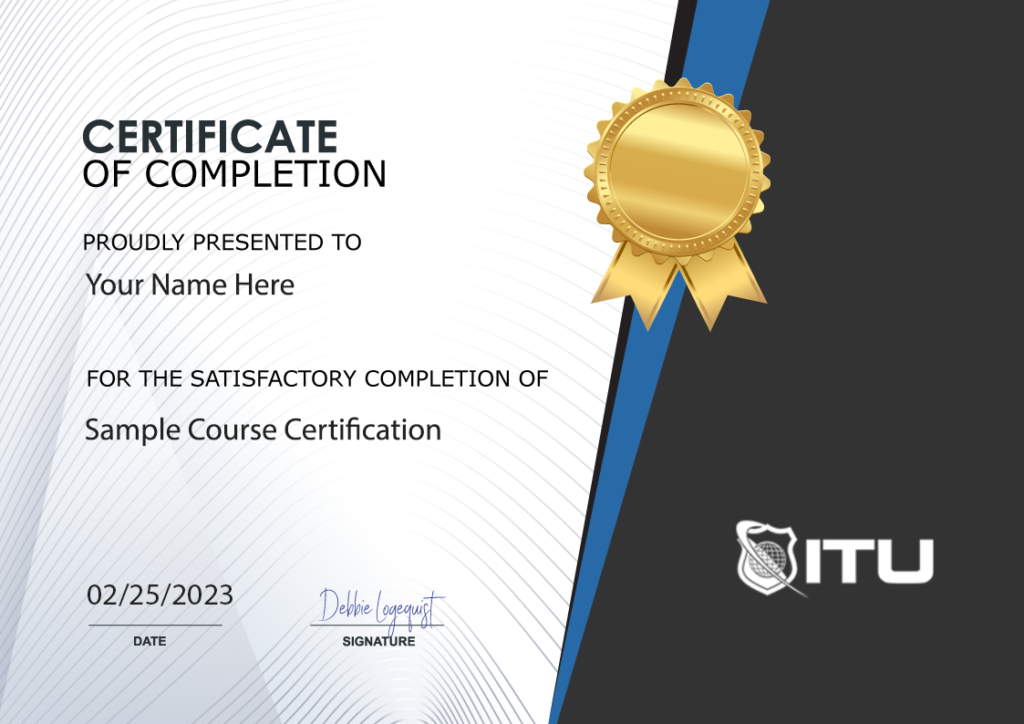CompTIA Security+ Certification Course (SY0-701)
Master cybersecurity with our Security+ 701 Online Training Course, designed to equip you with essential skills for protecting against digital threats. Ideal for aspiring security specialists, network administrators, and IT auditors, this course is a stepping stone to mastering essential cybersecurity principles and practices.
Included In This Course



Closed Captions



Certificate of Completion
The CompTIA Security+ certification is a globally recognized credential that validates the foundational skills necessary for a career in IT security and cybersecurity. It serves as a benchmark for best practices in IT security, covering essential principles for network security and risk management.
Key Features of CompTIA Security+:
- Vendor-Neutral Certification: Applicable across various IT environments, providing flexibility in career opportunities.
- Comprehensive Coverage: Encompasses a wide range of security topics, including threats, vulnerabilities, cryptography, and access control.
- Performance-Based Questions: Assesses practical skills through hands-on simulations, ensuring candidates can apply knowledge effectively.
Benefits of Earning the CompTIA Security+ Certification:
- Career Advancement: Qualifies professionals for roles such as security administrator, systems administrator, and network engineer.
- Industry Recognition: Acknowledged by employers as a credible validation of security skills.
- Compliance with Standards: Approved by the U.S. Department of Defense to meet Directive 8140.03M requirements.
Exam Details:
- Exam Code: SY0-701
- Number of Questions: Maximum of 90
- Question Types: Multiple-choice and performance-based
- Duration: 90 minutes
- Passing Score: 750 on a scale of 100-900
- Recommended Experience: CompTIA Network+ and two years of experience in IT administration with a security focus.
Cost Considerations:
- Exam Voucher: Approximately $404 in the U.S.
- Training Materials: Costs vary based on chosen resources, ranging from free online materials to paid courses.
- Retake Policy: CompTIA offers retake vouchers; consider purchasing a bundle that includes a retake option.
Maintaining Certification:
- Continuing Education Units (CEUs): Earn CEUs through activities like attending webinars, publishing articles, or completing related certifications.
- Renewal Cycle: CompTIA Security+ certification is valid for three years and can be renewed by earning CEUs or passing the latest exam version.
By obtaining the CompTIA Security+ certification, professionals demonstrate their commitment to cybersecurity excellence and enhance their prospects in the IT industry.
Frequently Asked Questions Related to CompTIA Security+ 701
Can I get a job with CompTIA Security?
Yes, earning the CompTIA Security+ certification can open the door to a variety of IT and cybersecurity job opportunities. It is widely recognized as a foundational certification for entry-level cybersecurity roles.
- Common Job Roles:
- Security Analyst
- Systems Administrator
- Network Administrator
- IT Auditor
- Junior Penetration Tester
- Why Employers Value It:
- Meets U.S. Department of Defense (DoD) 8570 requirements.
- Demonstrates baseline skills in risk management, network security, and incident response.
- Serves as a prerequisite for more advanced certifications like CISSP or CEH.
How long to study for CompTIA Security?
The time needed to study for the CompTIA Security+ exam depends on your background and experience:
- Recommended Study Time:
- Beginner: 3–6 months if you’re new to IT and cybersecurity.
- Intermediate: 1–3 months if you have prior experience in networking or basic security concepts.
- Factors to Consider:
- The number of study hours per week (e.g., 10–15 hours).
- The resources you use (e.g., online courses, study guides, or practice exams).
- Your familiarity with topics like threat analysis, cryptography, and risk management.
How many parts in CompTIA Security?
The CompTIA Security+ certification exam (SY0-601) consists of:
- Exam Format:
- Maximum of 90 questions.
- Includes multiple-choice, drag-and-drop, and performance-based questions.
- Domains Covered:
- Threats, Attacks, and Vulnerabilities: 24% of the exam.
- Architecture and Design: 21%.
- Implementation: 25%.
- Operations and Incident Response: 16%.
- Governance, Risk, and Compliance: 14%.
How much is the CompTIA Security exam?
The cost of the CompTIA Security+ certification exam varies based on location and whether you purchase a bundle:
- Base Exam Fee: $404 USD (as of 2024).
- Discounts and Bundles:
- Discounts are available for students, veterans, and bulk purchases.
- Certification bundles may include exam vouchers, study materials, and retake options.
- Additional Costs:
- Study resources: $50–$300 depending on the material.
- Training courses: $200–$1,000 for instructor-led or self-paced options.
Is CompTIA Security open book?
No, the CompTIA Security+ exam is not open book. It is a proctored exam designed to test your knowledge and problem-solving skills under exam conditions.
- Exam Rules:
- You are not allowed to use reference materials, notes, or online resources during the test.
- Both in-person and online proctored exams require strict adherence to security protocols.
- Preparation Tips:
- Focus on understanding key concepts like encryption, authentication, and incident response.
- Use practice tests to simulate the exam environment and time constraints.
Blogs of Interest Related to This Course
- Getting Started in IT: Tips for Jumpstarting Your Career
- Security+ Certification: Unlocking a Career in Cybersecurity
- Securing the Digital Future: Navigating the Rise of Remote Cybersecurity Careers
- 10 Essential Cybersecurity Technical Skills for Success
- Top In-Demand Tech Jobs for 2023: Salaries and Trends
- CompTIA Stackable Certs : Certications To Propel Your IT Career
- Is CySA+ Worth It?
- CySA+ Objectives - A Deep Dive into Mastering the CompTIA Cybersecurity Analyst (CySA+)
- CASP Training: Your Pathway to Advanced Security Proficiency
- 5 Reasons Why You Should Consider CompTIA ITF+ Training
Proudly DisplayYour Achievement
Upon completion of your training, you’ll receive a personalized certificate of completion to help validate to others your new skills.
CompTIA Security+ SY0-701 Course Content
Module 1 - SY0-701 General Security Concepts
- 1.0 Introduction to the Course
- 1.1 Fundamental Security Concepts
- 1.2 Zero Trust
- 1.3 Deception and Disruption
- 1.3.1 ACTIVITY - Testing a Honeypot
- 1.4 Security Controls
- 1.5 Change Management and Security
- 1.6 Cryptography Basics
- 1.6.1 ACTIVITY - Examining Symmetric Encryption
- 1.7 Asymmetric Encryption
- 1.7.1 ACTIVITY - Exploring Asymmetric Encryption
- 1.8 Hashing
- 1.8.1 ACTIVITY - Verifying Integrity with Hashing
- 1.9 Digital Certificates
- 1.10 Public Key Infrastructure
- 1.11 Data and Keys
- 1.12 Crypto Implementations
- 1.13 Blockchain
- 1.14 Non-Cryptographic Data Protection
Module 2 - SY0-701 Threats, Vulnerabilities, and Mitigations
- 2.1 Threat Actors and Motivations
- 2.2 Threat Vectors
- 2.2.1 ACTIVITY - O.MG Cable Baiting
- 2.2.2 O.MG-No Cable
- 2.3 Social Engineering
- 2.4 Operating System Vulnerabilities and Attacks
- 2.5 Application Vulnerabilities and Attacks
- 2.5.1 ACTIVITY - Performing a Buffer Overflow
- 2.6 Web-based Vulnerabilities and Attacks
- 2.6.1 ACTIVITY - Abusing Unsanitized Input
- 2.6.2 ACTIVITY - Grabbing Passwords with SQL Injection
- 2.6.3 ACTIVITY - Swiping a Token with XSS
- 2.7 Other Vulnerabilities
- 2.8 Common Malicious Activity Indicators
- 2.9 Insider Threat Indicators
- 2.10 Social Engineering Indicators
- 2.10.1 ACTIVITY - Capturing Credentials through Social Engineering
- 2.11 Malware Activity Indicators
- 2.12 Operating System Attack Indicators
- 2.13 Application Attack Indicators
- 2.13.1 ACTIVITY - Recognizing Directory Traversal
- 2.14 Physical Attack Indicators
- 2.14.1 ACTIVITY - Quickly Cloning an RFID Badge
- 2.15 Network Attack Indicators
- 2.15.1 ACTIVITY - Crashing a Target with DoS
- 2.16 Cryptographic Attack Indicators
- 2.17 Password Attack Indicators
- 2.17.1 ACTIVITY - Password Cracking
- 2.18 Network Segmentation
- 2.19 Access Control
- 2.20 Enterprise Device Hardening
Module 3 - SY0-701 Security Architecture
- 3.1 Network Segmentation
- 3.1.1 ACTIVITY - Segementing a Network
- 3.2 High Availability
- 3.3 Virtualization
- 3.3.1 ACTIVITY - Deploying Docker Containers
- 3.4 Cloud
- 3.5 Serverless Computing
- 3.6 IoT
- 3.7 ICS SCADA
- 3.7.1 ACTIVITY - Operating a SCADA System
- 3.8 RTOS and Embedded Systems
- 3.9 Reducing the Attack Surface
- 3.10 Firewalls
- 3.11 IDS IPS.mp4
- 3.12 Secure Communications - Access
- 3.13 Port Security
- 3.14 SD-WAN and SASE
- 3.15 Data Classifications
- 3.16 Protecting Data Types
- 3.17 Data Considerations
- 3.18 Redundancy
- 3.19 Alternate Sites
- 3.20 Multiple Platforms
- 3.21 Business Continuity
Module 4 - SY0-701 Security Operations
- 4.1 Secure Baselines
- 4.2 Attack Surface Reduction
- 4.3 Wireless Installation
- 4.4 Wireless Security Settings
- 4.5 Mobile Solutions
- 4.5.1 ACTIVITY - Pwning a Mobile Device
- 4.6 Application Security Management
- 4.7 Asset Management
- 4.8 Vulnerability Management
- 4.9 Monitoring Activities
- 4.10 Monitoring Tools
- 4.10.1 ACTIVITY - Scanning a Network for Vulnerabilities
- 4.11 Firewall Configuration
- 4.11.1 ACTIVITY - Configuring Firewall Rules
- 4.12 Intrusion Detection Configuration
- 4.13 Web Traffic Filtering
- 4.14 Operating System Policy
- 4.14.1 ACTIVITY - Examining Windows Group Policy
- 4.15 Network Service Security
- 4.16 Data Loss Protection
- 4.16.1 ACTIVITY - Checking File Integrity
- 4.17 Network Access Control
- 4.17.1 ACTIVITY - Require Multifactor Authentication
- 4.18 Identity Management
- 4.19 Access Management
- 4.19.1 ACTIVITY - Implementing Access Control
- 4.20 Security Automation
- 4.21 Incident Response
- 4.22 Digital Forensics
Module 5 - SY0-701 Security Program Management and Oversight
- 5.1 Elements of Effective Security Governance
- 5.2 Elements of the Risk Management Process
- 5.3 Third Party Risk Assessment and Management
- 5.3.1 ACTIVITY - Analyzing the Solar Winds Supply Chain Failure
- 5.4 Effective Security Compliance
- 5.5 Audits and Assessments
- 5.5.1 ACTIVITY - Conducting OSINT
- 5.5.2 ACTIVITY - Performing Active Reconnaissance
- 5.6 Security Awareness Practices
- 5.7 Course Outro
| 5 star | 82 | 82% |
| 4 star | 17 | 17% |
| 3 star | 1 | 1% |
| 2 star | 0% | |
| 1 star | 0% |
Sorry, no reviews match your current selections
Your Training Instructor
Chrys Thorsen is an education and technology expert who specializes in enterprise-level IT infrastructure consulting and certified training-of-trainers. In her career, she has garnered over 50 IT Certifications including CISSP, CISA, CEHv12, PenTest+, CompTIA CNVP, Cisco CCSI/CCNP, Microsoft Cloud and on-premises technologies, VMware vSphere, and many more. She has also authored 40 published certification textbooks, and over 35 full-length IT certification video courses.
When not working in the United States, Chrys spends her time abroad capacity-building IT literacy in developing nations in Sub-Saharan Africa. Her client list has included: the US Federal Government, the Republic of Zambia Ministry of Health, Cavendish University Zambia, Accenture, JP Morgan Chase, the US Centers for Disease Control and Prevention, the Elizabeth Glaser Pediatric AIDS Foundation (EGPAF), Hughes Aircraft, Microsoft, and many more.
Chrys lives by, and is fond of repeating, her professional creed:
“The only true measure of success for any project or training is results on the ground. Everything else is just noise.” “I teach what I deploy; I deploy what I teach.”

Subscribe To All-Access
Lock In $16.99 / Month Forever
Access this course and over 2,900 hours of focused IT training. Start your first month for only $1.00. Then lock in only $16.99 / month for life.
- Get Every Course
- Free Updates / New Content Added
- 2,900+ Hours of IT Training
- Price Lock Guarantee
- Games / Flashcards
- 22,000+ Practice Questions
- AI Study Buddy
- Certificates of Completion
$49.99 $16.99 Monthly
$49.00





good
Smooth delivery and easy access to LMS. Good to see that the LMS offers progress tracking. Would be great if badges were offered on completion of courses to share via Credly to future employers.